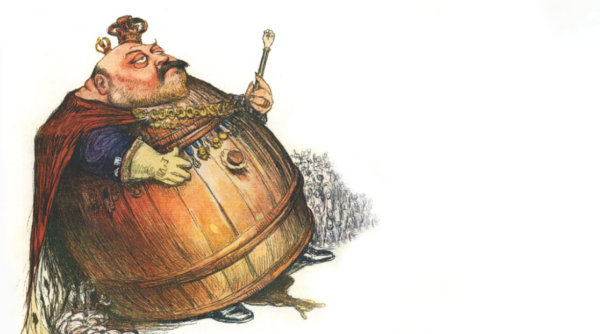A Meal Fit for a King
Alexander Larman takes us on a tour of coronation banquets past

By Alexander Larman
July 5 2023
In Shakespeare’s Julius Caesar, the emperor muses to his friend Mark Anthony, “Let me have men about me that are fat / Sleek-headed men and such as sleep o’nights.” His correct assessment being that the treacherous Cassius has “a lean and hungry look”. He rightly surmises, “He thinks too much: such men are dangerous.”
Although few would accuse many of the members of the current Royal Family – bar the new king – of thinking too much, it is undeniably true that there is not a well-stuffed or decently-fed man or woman amongst them.
Charles, Camilla, William, Harry – all positively sylph-like, although the disgraced Duke of York, at
least, looks like a man who knows the value of a good dinner. Even if it does have to be taken at the Pizza Express in Woking. The senior royals eschew wine and are instead, notoriously, committed gin drinkers, whether with tonic or as martinis, and the new king is said never to eat lunch and to breakfast sparsely on fruit and seeds. Whatever floats your royal yacht, eh?
For those of us trenchermen and trencherwomen (‘trencherladies’?) for whom a table-groaning repast is not merely a luxury but a necessity, the lack of interest that The Firm appears to take in eating and drinking is both a disappointment and a poor example for their subjects.
I am still recovering from the flaccid horror that was the “Coronation quiche”. It may have contained “delicate flavours of spinach, broad beans and fresh tarragon”, but there was very little that was regal about it. No wonder that at the Buckingham Palace Coronation lunch, it appeared merely in canapé form, to be washed down with a glass of champagne. I can only imagine that Camilla, especially, would have grimaced at it, before moving onto the other delights offered.
Even these, however, were less impressive than at coronation feasts in bygone days. It was announced that the newly-crowned king and his family would partake of a “Big Lunch” of roast rack of lamb with Asian-style marinade, prawn tacos with pineapple salsa, and strawberry and ginger trifle, but it’s a far cry from the spread that was served at the last coronation in 1953.
Then, the new Elizabeth II, Prince Philip and the other guests dined on a menu that contained “Poulet Reine Elizabeth”, or Coronation Chicken, created by the Cordon Bleu school in London, as well as the likes ot the tempting-sounding “Potage de Tomate à l’Estragon”, “Truite de Rivière”, “Galettes aux Fraises”, “Roulade” and, naturally, “Mousse au citron”.
The whole shebang was washed down with vintage Krug from 1945 – a reminder, surely, of VE Day and the country’s last great triumph. So successful was the banquet on 3 June that a reprise was held the following day, in the Ballroom at Buckingham Palace.
It’s a wonder that there was any Krug left in the country, or the world for that matter, after the libations and celebrations undertaken. However, at the time, Queen Elizabeth’s coronation was seen as low-key and austere in comparison to previous feasts. Britain in 1953 was still emerging from a ruinous war and was mired in rationing and penny-pinching. It would not have been politic to have held a banquet like the one that her father enjoyed at his coronation in 1937, which boasted eight courses including chicken covered in white truffles, quail stuffed with foie gras, and a little-known French delicacy: Quiche Lorraine. There were even dishes named after the various members of the Royal Family, in keeping with tradition. The king lent his name to the “consommé Georges VI”, a strong chicken soup, and his ever-icy mother Queen Mary had some biscuits described as “Biscuits glacés Reine Mary”, which may or may not have amused a woman who was seldom likened to a sweet treat.

Yet the most recent member of the Royal Family who truly took delight in gourmandising, as well as many other pleasures of the flesh, was Edward VII. The last truly stout monarch that Britain had, with a waist measuring a substantial 48 inches shortly before his coronation, it is he who we must thank for the introduction of roast beef and Yorkshire pudding to the dinner table, complete with horseradish sauce.
It was not as a result of his love of food that his coronation feast, planned for 26 June 1902, had to be postponed – the reason was a severe attack of appendicitis – but the chefs and organisers found themselves in a quandary, given that the coronation was only called off two days before it was due to take place. The wine and champagne and brandy would all keep until the rescheduled ceremony in August, the caviar could be kept on ice for two months, and an innovative royal cook, Gabrielle Tschumi, recalled that “jellies were melted down and stored in magnum champagne bottles”.
However, there was a major problem. Many of the lavish dishes – such as pheasant consommé and breast of snipe stuffed with truffles and foie gras – would simply spoil if they were not eaten, and there was too much food simply to be divided up amongst the royal staff. In the end, it was the Whitechapel charity, Sisters of the Poor, who received the cast-offs in their entirety and one can only imagine how endlessly they would have talked of the unexpected but lavish feast with which they were greeted.
When the Royals are not celebrating their coronations or similar state events, their tastes are altogether plainer. Prince William has confessed that his favourite foods are full English breakfasts and steaks, although, as befits a health-conscious future king, he is more likely to be found eating eggs and wholemeal toast for breakfast and a simply grilled white fish for dinner. Prince Harry, meanwhile, is lost to a world of acai smoothies and vegan muffins in California. But I do hope that a gourmand will emerge from their ascetic ranks, someone who loves the pleasures of the table, and that the next coronation feast will be one for the ages.
Prince George, a nation counts on you. Don’t let us down, your Majesty.
Alexander Larman’s “The Windsors at War: The Nazi Threat to the Crown” is out now (W&N Publishing)
